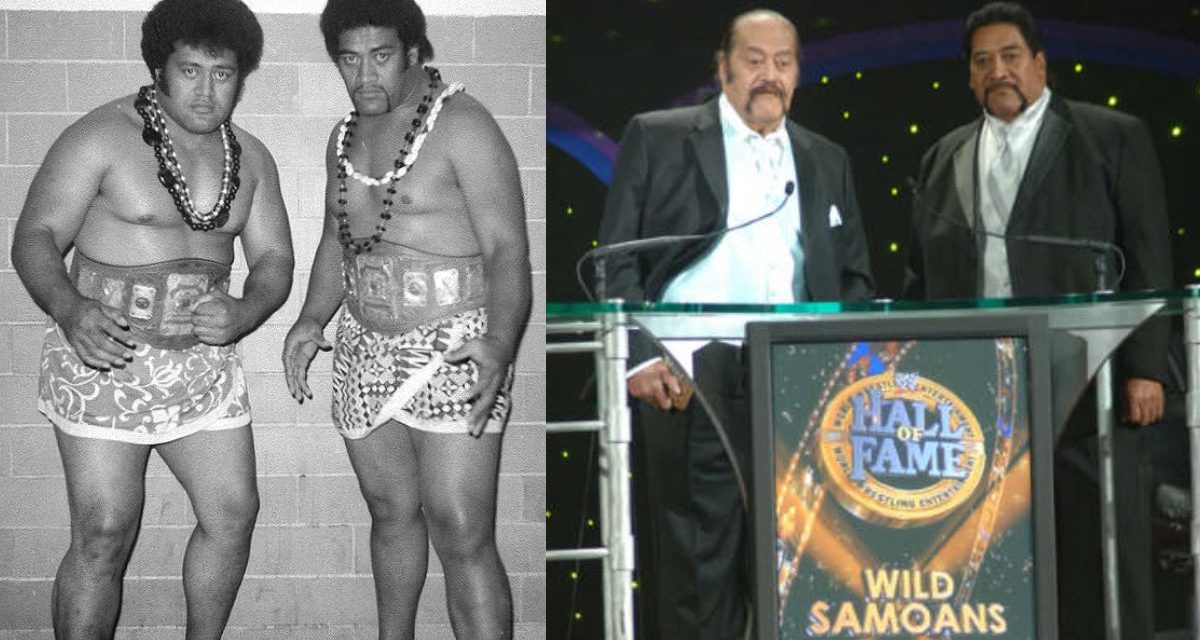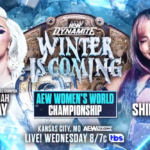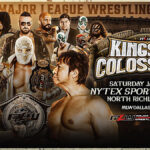If the teachings of wrestling are to be believed, Samoa is an uncivilized tropical island inhabited by wild-eyed savages who like to eviscerate raw fish with their teeth, are impervious to head-butting and are all related to one another.

The Wild Samoans, Afa and Siki, as tag team champions in Stampede Wrestling. Photo by Bob Leonard
But sometimes — not often, but sometimes — things in the real world are not exactly as depicted in professional wrestling. Shocking, I know, but hear me out.
What if the people and culture of Samoa have, in subtle but important ways, been misrepresented by their portrayal in the wrestling ring?
With this question in mind, I set out to separate the facts from fiction in professional wrestling’s depiction of Samoans.
Fiction: Samoans are sometimes identified only by numbers.
Fact: All Samoans have names, despite the appearance of a tag team in the WWWF in the 1970s whose members were known only as Samoan #1 and Samoan #2. They turned out to be Sika and Afa, thus proving that Samoans do actually have names. It’s uncertain whether the same can be said for Conquistadors 1 and 2, or Executioners 1 through 3.
Fiction: Samoans speak in an obscure dialect of grunts and hollers that can only be understood and translated by Captain Lou Albano.
Fact: Despite his being a captain, it’s unknown whether Lou Albano actually sailed his vessel to Samoa. Had he done so, he would have discovered that the official languages of the island nation are Samoan and English. Dangling an elastic band from a piercing in one’s cheek, incidentally, is not a Samoan custom.
Fiction: Samoans like to disembowel raw fish with their teeth.
Fact: The traditional Samoan diet is rather bland, made up of starchy roots, coconuts, fruit and boiled rice. An influx of Western food over the past half-century has given many Samoans a taste for deep-fried McJunkFood, and led to an overall tubbifying of the people. While fish are indeed plentiful around Samoa, and it is sometimes served raw, most Samoans prefer it thinly filleted and marinated in a coconut cream and lemon juice sauce, enlivened with a dash of salt and pepper.
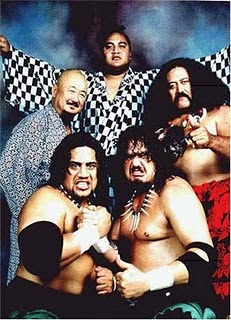
Clockwise from top left: Mr. Fuji, Yokozuna, Afa, and the Headshrinkers, Samu and Fatu.
Fiction: Samoan people can suddenly turn Japanese.
Fact: Yokozuna, despite wearing sumo attire, waving a Japanese flag and being managed by the devious Mr. Fuji, was purely Samoan, not Japanese. This should have been made obvious by his inability to utter a single Japanese phrase aside from “banzai” (which actually originated in China before becoming a Japanese war cry). Samoa is 7,510 kilometres from Japan, with little cultural overlap.
Fiction: Samoans do not have surnames.
Fact: This is a forgivable fallacy, since practically no Samoan wrestler has ever been billed with a surname. So we are left to assume that Samoan birth certificates bear only a single name, like Afa, Sika, Umaga, Samu, Rikishi, Jamal, Tama and Rosey. However, all these wrestlers do indeed have last names — almost certainly Anoa’i or Maivia — which brings us to our next subject …
Fiction: All Samoans are related to one another.
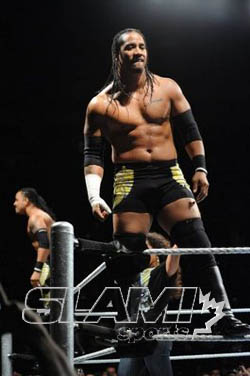
The Usos. Photo by Mike Mastrandrea
Fact: If pro wrestling were indeed an accurate microcosm of the world, then we would have to assume that Samoans are all in fact related by blood. Sika and Afa are brothers, the latter of whom begat Samu, Manu and the lesser-known L.A. Smooth. Both Sika and Afa are uncles to the late Yokozuna. Sika fathered Rosey, whose kin include the Tonga Kid, the late Umaga and Rikishi, who is the father of Jimmy and Jey Uso. Confused? That’s nothing. Sika and Afa referred to High Chief Peter Maivia as their uncle, making him an honorary (if not biological) member of the Anoa’i clan. Peter married Samoan wrestling promoter Leah Maivia; their daughter, Ata, married Rocky Johnson, who had a successful wrestling career, though not nearly as successful as that of his son, The Rock. In real life, not all 179,000 residents of Samoa are blood relatives. Honest. Hey, Samoa Joe is neither a Maivia nor an Anoa’i.
Fiction: In battle, Samoan warriors vanquish their enemies by hoisting them onto their shoulders and plunging backward.
Fact: Despite its name, the “Samoan Drop” is not a commonly used method of attack in real-life Samoa. In Samoa, only firemen tend to use the over-the-shoulder “fireman’s carry,” and they only fall backward by accident. It’s worth noting that the so-called “Samoan Spike” — a heavily taped thumb to the throat — also has no basis in Samoan warfare. It does, however, bear an uncanny resemblance to the Asiatic spike that both Terry Gordy and Magnificent Muraco learned during their tours of the Orient. Further anthropological research into the thumb-to-the-throat attack is needed to discern its true cultural origins.

Umaga. Photo by Mike Mastrandrea
Fiction: Samoans like to put their butts in people’s faces.
Fact: The habits of Rikishi and Umaga notwithstanding, typical Samoans do not make a habit of squishing their bums into the faces of semi-conscious people. Unlike Umaga, they do no slam their butts into people’s faces at high speeds. Nor do they slowly, repulsively reverse their corpulent gluteus maximi into the faces of mortified victims, as Rikishi did with his dreaded “Stinkface.” Real Samoans have better manners than that.
So there you have it. In real life, Samoans are the civilized and peaceful inhabitants of a beautiful island in the South Pacific, and not the maniacal, uni-named fish-disembowlers portrayed over the decades in the squared circle.
Believe it or not, there still seem to exist a few politically incorrect stereotypes, cultural fallacies and historical half-truths in professional wrestling. I’m already envisioning for future fact-vs-fiction columns: “Not all Mexicans wear masks,” “Not all women have breast implants” and “Not all Iranians hate B. Brian Blair.”
